Creation Myths
|
by Stefan Stenudd |
We have no way of fixing the time when man developed language. It seems to have been present at least some 50,000 years ago, but it could have been introduced in some primeval form more than 100,000 years ago.
Of course it evolved slowly from an extremely limited number of word representations of natural objects and phenomena, into the complexity that we find already in the oldest written texts preserved. Only when language got rich enough to carry such oddities as images of things never seen and creatures never met, would it be able to transmit creation stories of any complexity.
We tend to assume that this came very late, maybe not far before the dates of the oldest archaeological remains of civilization.
For example, do the cave paintings in Lascaux, assumed to be around 20,000 years old, suggest that their artists must have possessed a language intricate enough to transmit something akin to a creation myth?
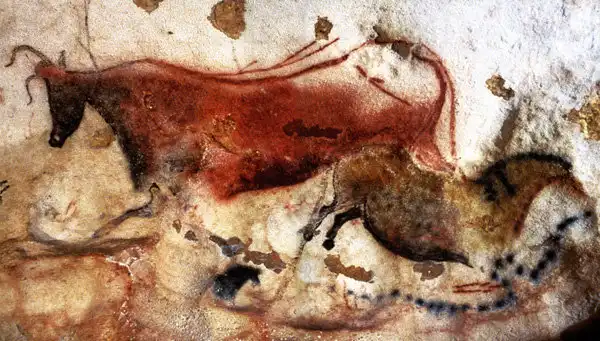
Cave painting from Lascaux, France.
From numerous societies of hunters and gatherers we know that writing is not needed to transmit even very complex ideas and sophisticated stories, but they certainly demand the existence of many words that represent things at which one cannot point. They need a language with a high level of abstraction and words that can paint pictures of things that nobody has seen.
We find it hard to accept anything else than that this would have been highly unlikely mere centuries before the emergence of the ancient civilizations that we still know quite a lot about, and from which there are many remnants proving their advancement.
But man is a tricky beast. Once he gets a process started, he seems able to take it further than he ever imagined beforehand – and faster than he would ever have hoped. This is particularly true for things of the mind. The brain is an organ of great resources at immediate disposal to each of us.
It is possible that language evolved by the help of hand signs, which must have been present before spoken words. But they were probably not of any complexity, or we would have remnants of this. In an initial process, the understanding of words was probably shared by pointing at the objects they represented, and methods of that kind.
This would demand of the objects to be concrete and visible. The same would be true for actions described. Such a language would not immediately express the abstract or past tense, both necessary for a creation story.
But there would have been an eagerness in man also to find a language for all those things of major significance to him, such as the most dramatic events in life – birth and death, and how to accomplish the former and avoid the latter. These lines of thought lead to just about everything.
The evolution of language probably followed these two lines: simplicity and urgency. Objects or actions that were easy to define were quickly given words, and so were – out of necessity – words to deal with urgent matters.
The All Was Born in the Past
So, the very first creation stories possible are those told with words of simplicity and urgency. Birth is likely to be an early word, so it was surely used in a primeval creation story, where it makes very much sense. The birth of a human being is easy enough to point out, and therefore also to establish a word for – but what about the birth of the whole world? Well, that would be the birth of all, which is not that difficult to convey with gestures, so this concept may well have been possible to express very early in the development of language.This suggests that the imagery of a primeval creation is that of a birth – out of something yet to be described, a creature or object as unimaginable as it is lacking words. Then the mystery to the people who were the first to speculate on the matter was not the birth of the world, but out of what it was born.
Actually, we have the same problem today.
It is possible that this mysterious nameless entity out of which the world was born according to the primeval creation story, was the gap that later had to be filled with the invention of what we call deities. But of course, there were other options. The one most commonly used in creation myths is the sea. It's the primordial ever-present entity in many creations, where the world is born by land rising up from it, or falling into it.
Anyway, the probable development of language suggests that speculations about creation, the birth of all, could have commenced quite early in that process. The most difficult thing to convey, except for the entity out of which the world may have been born, was the past tense.
But in this case it would have been obvious, as it would with any creature or thing possible to point out. Somebody or something pointed at, combined with a sign indicating birth, would be understood as the previous birth of that someone or something, i.e. something of the past.
In the same fashion, the future tense would be assumed when mentioning death and pointing on anyone still alive. Therefore, I doubt that this part of grammar took that very long to appear, at least in a rudimentary way.
That’s really everything needed for a primeval creation myth: The all was born in the past. Already this is saying a lot.
Also, the language of the primeval creation story suggests another statement: The all will die in the future. It is very likely that such ideas were fostered at the same time and given equally significant meaning. But that's beyond the scope of this text.
Originality
The search through primeval language and the mind of Homo rudis finds a lot of similarities to be expected in creation myths of old. This is indeed the case. But there are also significant differences between the myths we know. When we have found plausible explanations for the similarities we learn to expect them – then we need to understand the reasons for the many differences we find.We should try at first to explore how these differences can be explained through universal patterns of human thought. Otherwise we have abandoned the idea that there are such things, and we lose the explanations we already found for the similarities.
The differences can be explained along the lines of the triangle of functions of creation myths, presented above.
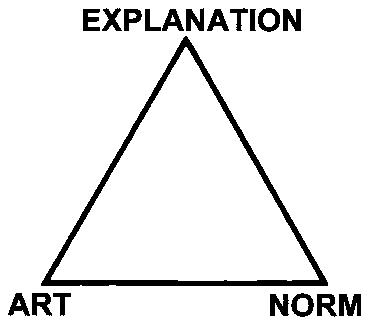
The triangle of functions in creation myths.
Firstly, the explanation that would come to mind to any inventor of a creation myth would have to make sense in that person’s environment. So, a primordial sea is a plausible image among people living near an ocean, but otherwise quite unlikely.
There are many examples of a primordial sea in creation myths around the world. Genesis 1 of the Bible is one example of it. At its opening scene, God’s spirit hovers over the sea, before the actual creation is initiated. The creation of Genesis 2, though, mentions no such primeval water, but presents creation as one of the heavens and the earth, where there is no water, not even as rain, until God makes a mist appear from underground. This must be a creation imagined by people living very far from any sea, probably also from any lake. A river appears only by the formation of the Garden of Eden, soon to divide and spread water all over the world.
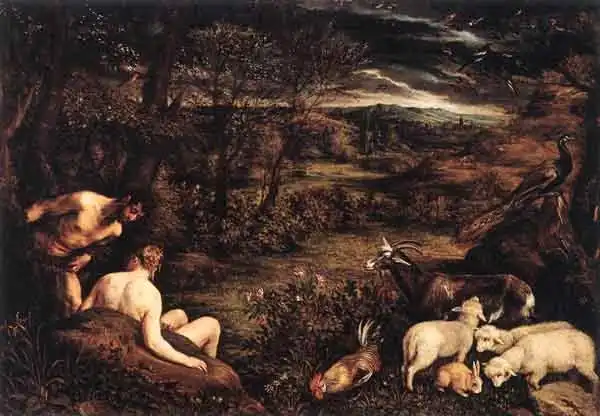
The garden of Eden. Painting by Jacopo Bassano, 1573.
The Babylonian creation myth Enuma Elish starts with two waters – the salt one of the mighty sea, and the fresh one of an underground lake. They are connected in the form of rain, whereby the creation of the world commences. Norse creation carries the image of ice meeting fire, which is indeed relevant in that cold climate. Without fire, how could life there emerge and remain?
In many more ways, the environment has influenced the content and logics of creation myths. So, differences between them should be examined from this aspect. Of course, a developed understanding of how the world works – and increased abilities to describe abstractions and complexities – has also influenced the creation myths, by altering them through time or by replacing old myths with completely new ones.
The norm corner of the triangle of functions has also influenced creation myths into characteristics deviating from common original forms. Those differences stem from the moral and regulatory intent of the myth, and the order of the society where it appeared. As mentioned above, the difference between agrarian societies and those of hunters and gatherers must show in the structures of their creation myths, particularly regarding the norms they advocate. This also leads to other variations, such as exactly how the generations succeed one another, how powers of command are distributed, and so on.
The norm corner of a myth mainly demonstrates its people’s view on its role in their surrounding, and what they regarded as most precious to strive for.
The artistic corner of the triangle dictates what can be called decorative ingredients, which are highly dependent on the environment of the people upholding the myth. That decides what kinds of spectacles they are able to fathom, and what their specific longings or aversions are. The drama of the myth also reveals a lot about how they regard human nature.
Again, we can refer to Genesis 2 and its continuing story, where Adam and Eve are the first to betray a trust, causing great misfortune. Then their own son does the same, even more violently so. This demonstrates a disillusioned view on human nature, to put it mildly.
Creation myths around the world are full of similar examples. Man is rarely praised in those myths, but very often portrayed as the real cause of all misery. Differences between creation myths are to be found concerning what specific type of shortcomings man is guilty of. There's always something.
To find what sets one creation myth apart from the universal standard, its inner structure has to be carefully examined – the plot, the ingredients, its moral, the natural laws it establishes, the personalities of its characters, and on and on. By such careful scrutiny, what seems at first to be universal can prove to be quite unique, and the other way around.
Next
- Introduction
- Man, Too
- Human Thought Revealed
- Trusting Creation Myths
- Time and Place
- Authenticity
- Inner Story Logics
- Function
- Triangle of Functions
- The Relief of Tragedy
- Homo Rudis
- Present Day Tribes
- Belief
- Doubt
- The Evolution of Creation Myths
- Subconscious Creation
- Simplicity and Urgency
- The All Was Born in the Past
- Originality
- Religion, Science, or Art
- What Can Be Reached
This text was written as an introduction of sorts to my ongoing dissertation on creation myths, at the Lund University History of Ideas and Learning.
Some of My Books:Click the image to see the book at Amazon (paid link).
The Greek philosophers and what they thought about cosmology, myth, and the gods. |
MENU
Creation Myths Around the World
How stories of the beginning began.
The Meanings of Mythology
Theories through history about myth and fable.
Archetypes in Myths
The mythological symbols and what they stand for.
The Logics of Myth
Patterns of creation.
CREATION MYTHS IN DEPTH
Creation in Rig Veda 10:129
The paradox of origin, according to an Indian myth.
Genesis 1
The first creation story of the bible scrutinized.
Enuma Elish
The ancient Babylonian creation myth.
Xingu Creation of Man
The insoluble solitude of gods and humans.
Contact
About Cookies
ON MY OTHER WEBSITES
Psychoanalysis of Myth
What Sigmund Freud and C. G. Jung thought about myths, their origins and meanings.
Jungian Theories on Myth and Religion
Joseph Campbell, Jordan B. Peterson and other Jungians on mythology and religion.
Myth of Creation
An introduction to the subject of creation myths and the patterns of thought they reveal.
Cosmos of the Ancients
What the Greek philosophers believed about the cosmos, their religion and their gods.
Life Energy
The many ancient and modern life force beliefs all over the world explained and compared.
Taoistic
Taoism, the ancient Chinese philosophy of life explained. Also, the complete classic text Tao Te Ching online.
 Stefan Stenudd
Stefan Stenudd
About me
I'm a Swedish author and historian of ideas, researching the thought patterns in creation myths. I've also written books about Taoism, the Tarot, and life force concepts around the world. Click the image to get to my personal website.
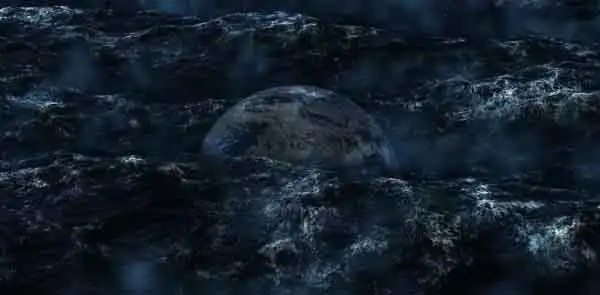
 Archetypes of Mythology
Archetypes of Mythology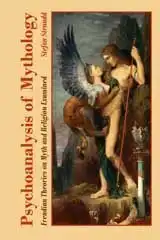 Psychoanalysis of Mythology
Psychoanalysis of Mythology Cosmos of the Ancients
Cosmos of the Ancients Life Energy Encyclopedia
Life Energy Encyclopedia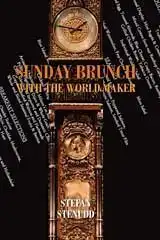 Sunday Brunch with the World Maker
Sunday Brunch with the World Maker Fake Lao Tzu Quotes
Fake Lao Tzu Quotes